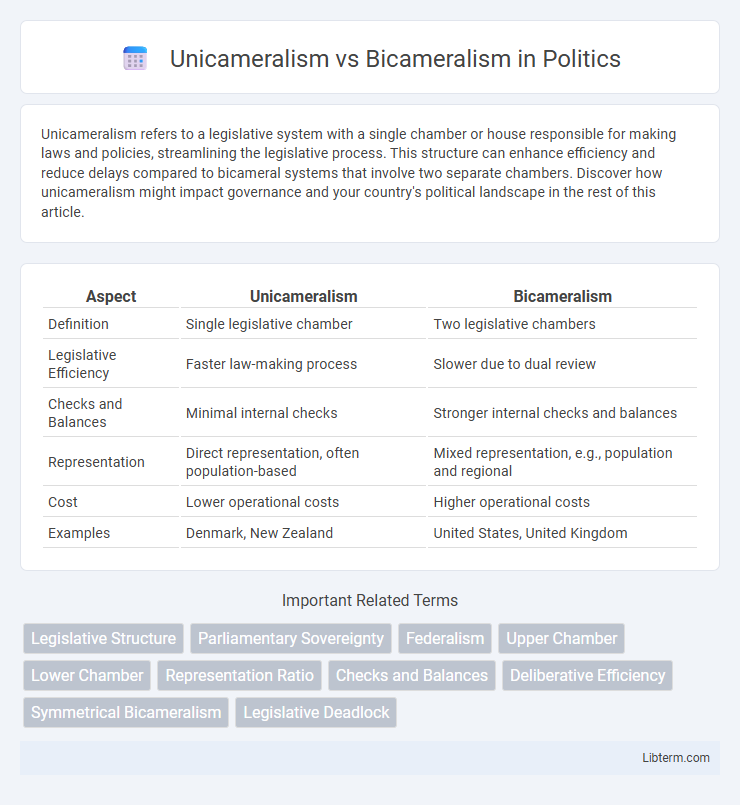Unicameralism refers to a legislative system with a single chamber or house responsible for making laws and policies, streamlining the legislative process. This structure can enhance efficiency and reduce delays compared to bicameral systems that involve two separate chambers. Discover how unicameralism might impact governance and your country's political landscape in the rest of this article.
Table of Comparison
| Aspect | Unicameralism | Bicameralism |
|---|---|---|
| Definition | Single legislative chamber | Two legislative chambers |
| Legislative Efficiency | Faster law-making process | Slower due to dual review |
| Checks and Balances | Minimal internal checks | Stronger internal checks and balances |
| Representation | Direct representation, often population-based | Mixed representation, e.g., population and regional |
| Cost | Lower operational costs | Higher operational costs |
| Examples | Denmark, New Zealand | United States, United Kingdom |
Introduction to Legislative Structures
Unicameralism features a single legislative chamber, streamlining lawmaking processes and often leading to faster decision-making. Bicameralism consists of two separate chambers, typically an upper and a lower house, designed to provide checks and balances within the legislative system. Many democratic countries adopt bicameral legislatures to ensure broader representation and prevent concentration of power.
Defining Unicameralism
Unicameralism is a legislative structure featuring a single chamber or house responsible for lawmaking, contrasting with bicameral systems that divide this power between two separate chambers. This streamlined approach often results in faster legislative processes and reduced governmental costs by eliminating the need for inter-chamber negotiations. Countries like Nebraska in the United States and New Zealand exemplify unicameral legislatures, emphasizing efficiency and simplicity in governance.
What is Bicameralism?
Bicameralism is a legislative system divided into two chambers or houses, typically an upper house and a lower house, designed to provide checks and balances within the legislative process. This structure aims to improve lawmaking by ensuring thorough debate, representation of different interests, and preventing hasty decisions. Countries like the United States and the United Kingdom utilize bicameral legislatures to balance power between varied social, political, or regional groups.
Historical Evolution of Legislative Chambers
Legislative chambers evolved from unicameral systems in ancient societies, such as the early Athenian assembly, to bicameral structures seen in medieval England's Parliament with the House of Commons and House of Lords. The shift was driven by the need to balance representation of different social classes and regional interests, enhancing stability and preventing concentration of power. Modern democracies often maintain bicameral legislatures to provide checks and balances, while some countries retain unicameralism for streamlined lawmaking and cost-efficiency.
Structural Differences: Unicameral vs Bicameral
Unicameralism features a single legislative chamber responsible for lawmaking, streamlining legislative processes and reducing redundancy. Bicameralism consists of two separate chambers, typically an upper and a lower house, which provide checks and balances through distinct powers and functions. Structural differences influence legislative efficiency, representation, and accountability within political systems.
Advantages of Unicameral Legislatures
Unicameral legislatures offer streamlined lawmaking processes that reduce redundancy and enhance legislative efficiency, allowing for quicker decision-making and implementation. With a single legislative chamber, government transparency and accountability improve as voters can more easily track representatives' actions and policies. Cost-effectiveness is another key advantage, as unicameral systems require fewer resources and lower operational expenses compared to bicameral counterparts.
Strengths of Bicameral Legislative Systems
Bicameral legislative systems strengthen democratic governance by providing a dual-chamber structure that promotes thorough scrutiny and debate of legislation, reducing the risk of hasty or ill-considered laws. The two chambers, often representing different interests such as population-based constituencies and territorial units, enhance checks and balances, preventing domination by a single group and ensuring diverse viewpoints are considered. This system fosters stability by requiring consensus across chambers, which can safeguard against sudden policy shifts and reinforce the legitimacy of legislative decisions.
Common Criticisms of Each System
Unicameralism faces criticism for potentially concentrating power too heavily in one legislative body, which can limit checks and balances and reduce diverse representation. Bicameralism is often criticized for causing legislative gridlock and inefficiency, as conflicting interests between two chambers can delay lawmaking. Both systems may struggle with accountability and responsiveness, yet the balance between efficiency and oversight remains a central debate in governance structures.
Global Examples and Case Studies
Unicameralism is exemplified by countries like Denmark and New Zealand, where a single legislative chamber streamlines decision-making and enhances legislative efficiency. Bicameralism, as seen in the United States and India, incorporates two chambers to provide checks and balances, safeguard minority interests, and enhance scrutiny of legislation. Case studies indicate that unicameral systems often promote faster law-making, while bicameral systems bolster representation and prevent hasty legislation in diverse or federal states.
Choosing the Right System: Key Considerations
Choosing between unicameralism and bicameralism involves assessing factors such as legislative efficiency, representation, and checks and balances. Unicameral systems offer streamlined decision-making and lower costs, ideal for smaller or more homogeneous populations. Bicameral systems enhance oversight and represent diverse interests, often preferred in larger, federal, or pluralistic states to prevent hasty legislation.
Unicameralism Infographic

 libterm.com
libterm.com